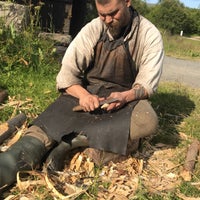

Vikingarir longphort upgrade#
(knowing this I later have added Comfort+ upgrade at self-pay add-on with the Viking air+ rep when making initial booking) BTW, the 'low' priority class fare Viking books doesn't qualify for later add-on upgrades - I planned to later add my own Delta Comfort+ upgrade and Delta agent said my airfare class excluded upgrades. Air+plus res for Prem-Econ air and airline later bumped them (presumably for full-fare customers). I was unhappy to read another CC-board poster say that they had their long-advance preferred-seat V. OF course they're probably short-staffed like many businesses AND the airlines may be imposing tighter restrictions on timing of their vendor partner contracts. Hi - I am aware of their 75-day-out restriction BUT I was hoping that if one had paid Air+ custom fee, especially if added upgrade like Prem-Econ, that they would process reservation sooner and that their 75-day policy applied to their default economy air offering.
Vikingarir longphort plus#
Under normal circumstances I would have contacted Viking Air Plus to arrange our flights but reading here it seems that they are not booking anything more than 75 days out. Copyright, Russell Ó Ríagáin, 2010.We have a Viking South East Asia cruise booked for April 2022. There seems to have been extensive Gaelic acculturation in the areas of greatest contact, such as the towns in each period. This was due to a combination of creolisation and hybridisation. While colonial acculturation was limited, over time their culture came to differ both that of their home regions and Gaelic society, which saw them become a “third nation” living in a “third space” (cf. Both groups continued to be regarded as foreign elements long after the apogee of each of colonial period.

However, this was largely unsuccessful in the mid-west, and can only be said to have been successful in the south-east, and even then only until the fourteenth century, at which time the colony receded substantially. It involved the total reorganisation of the landscape, with the introduction of several new monument forms in a hierarchical spatial organisation. In contrast to the elite replacement colonialism found in Anglo-Norman Ulster and Norman England, Anglo-Norman colonialism in the case-studies was totalising, characterised by plantation colonialism, which involved the inward movement of several orders of society, and the incorporation or displacement of native groups. It has therefore been categorised here as non-imperial opportunistic colonialism. It cannot be said to have had a domination sub-phase, rather it experienced a phase of incorporation, where the settlements came under the control of elements of the Gaelic elite.
Vikingarir longphort series#
Scandinavian colonialism was much more geographically limited, largely confined to a series of estuarine settlements which became towns over time, with possible accompanying hinterland settlement. The Anglo-Norman domination phase was characterised by a hierarchical configuration of monuments, including those forms already mentioned, along with masonry castles, nucleated and dispersed rural settlement and continental religious houses. Mottes and Scandinavian urban settlement belong largely to the consolidation phase. Campaign fortresses and other bridgeheads in the landscape such as the longphort and the ringwork largely belong to this phase. It analyses their spatial organisation and their impact on the landscape in terms of a model of colonialism based on three sub-phases: expansion, consolidation and domination. "This project examines Scandinavian and Anglo-Norman colonialism in two Irish case study regions, the south-east and the mid-west, by placing them on a continuum of social development. In this way, I will reach my conclusion as to why Kaupang failed and Dublin survived. Using archaeological field reports, contemporary primary source material, and secondary interpretation, I will examine the two sites side-by-side in order to discuss the key aspects of each town, including chronological history, the physical layouts of the sites and the buildings that were present, the monetary systems in place, the nature of their imports and exports, and the different peoples who inhabited them. Through the application of central place and network theory, I posit that both served as major nodal points within a well-connected intra- and inter-regional long-distance Scandinavian trade network. While the importance of Kaupang as a permanent settlement and active trading partner throughout the Scandinavian trade network has only just begun to be understood, Dublin has primarily been understood as an Irish town founded by Scandinavians instead of as a Scandinavian town that gradually became an Irish city. The paper compares and contrasts Kaupang and Dublin as two early Viking Age towns.


 0 kommentar(er)
0 kommentar(er)
